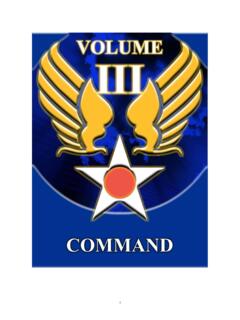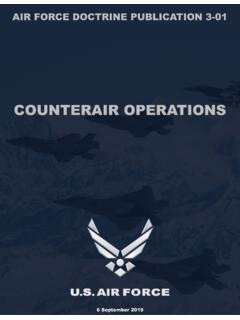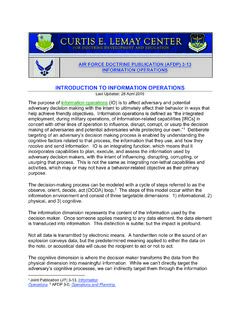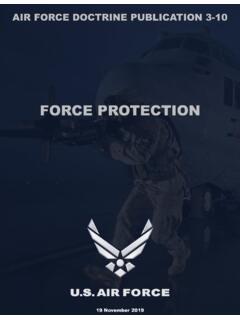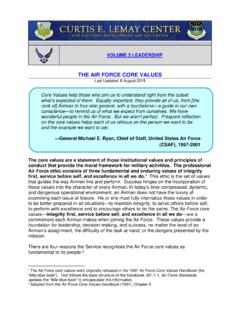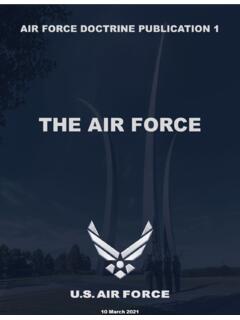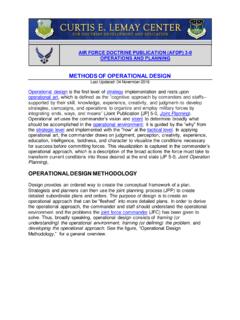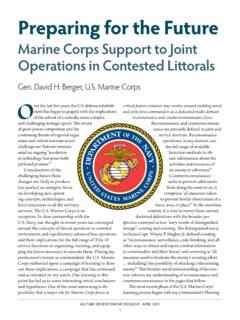Transcription of SPECIAL OPERATIONS - AF
1 AIR FORCE DOCTRINE PUBLICATION 3-05. SPECIAL OPERATIONS . 1 February 2020. AIR FORCE DOCTRINE PUBLICATION (AFDP) 3-05. SPECIAL OPERATIONS . INTRODUCTION TO SPECIAL OPERATIONS . Last Updated: 1 February 2020. SPECIAL OPERATIONS doctrine is constantly evolving. It should guide effective organization and employment of SPECIAL OPERATIONS across the competition continuum. As we continuously improve our airpower capabilities, our ability to revolutionize SPECIAL OPERATIONS and incorporate new concepts and technologies will shape future SPECIAL OPERATIONS doctrine. This AFDP captures the fundamental principles by which Air Force SPECIAL OPERATIONS forces (AFSOF) guide their actions to support national objectives. It articulates AFSOF. warfighting principles, lessons learned, and best practices for conducting Air Force SPECIAL OPERATIONS in a wide variety of scenarios in a complex global security environment.
2 Future SPECIAL OPERATIONS in a contested environment against a peer adversary require its air component to be more adaptive, resilient, and agile in its deployment and employment plans and leadership philosophies. This AFDP has three primary objectives. First, it describes Air Force guidance on the proper use of AFSOF in military OPERATIONS ; second, it discusses AFSOF's role in planning and executing SPECIAL OPERATIONS ; and third, it explains AFSOF's unique command relationships. SPECIAL OPERATIONS are rarely conducted as a single Service operation; therefore, SPECIAL OPERATIONS planning should consider joint support and coordination. As a contributor to the SPECIAL OPERATIONS joint force, AFSOF conduct and support specific SPECIAL OPERATIONS core activities. The SPECIAL OPERATIONS core activities, and the AFSOF core missions, which support those activities, will be discussed in Core Activities and Core Missions.
3 This AFDP provides an overview of the Airman's perspective of the SPECIAL OPERATIONS core activities, while other AFDPs discuss some of these activities in much greater detail. AFSOF CHARACTERISTICS. AFSOF are distinct from conventional forces (CF). Commanders should be familiar with AFSOF characteristics, as well as SPECIAL OPERATIONS forces (SOF) capabilities and limitations, to better conduct OPERATIONS . 1. AFSOF conduct joint and combined training within the SOF community and the CF. When employed, SOF are presented with their command and control (C2) structure intact, which facilitates their integration into joint force plans, retains cohesion, provides a control mechanism to address specific SOF concerns, and coordinates their activities with other components and supporting commands. AFSOF routinely operate closely with other government agencies, intergovernmental organizations, nongovernmental organizations, and other nations' forces.
4 Clandestine and low-visibility SPECIAL OPERATIONS may require detailed interagency and international coordination. Additionally, AFSOF require unique training, education and the development, acquisition, and employment of weapons and equipment not standard to the force. Certain AFSOF personnel undergo a rigorous selection process and mission-specific training beyond basic military skills to achieve proficiency in entry-level SPECIAL OPERATIONS skills. AFSOF units normally include seasoned personnel, many of whom maintain high levels of competency in more than one military specialty. Select AFSOF are regionally, culturally, and linguistically oriented for employment. Extensive language training and cross-cultural education are routine parts of their development. Some personnel require highly technical and advanced training to accomplish assigned missions. AFSOF can be formed into versatile, self-contained teams that provide an agile and adaptable force capable of operating in dynamic environments.
5 AFSOF can: Deploy rapidly to provide tailored responses to different situations. Gain access to hostile, denied, or politically sensitive areas to prepare the operational environment for future OPERATIONS and develop asymmetric options for addressing ambiguous situations. Conduct OPERATIONS in most environments with minimal support, low profile, and non- intrusive presence. Communicate globally using organic equipment. Work closely with regional military and civilian authorities and populations. Survey and assess local situations and report these assessments rapidly. Execute SPECIAL OPERATIONS missions using SOF-unique equipment. 2. AFSOF MISSION CONSIDERATIONS. Before planning or conducting SPECIAL OPERATIONS missions, SOF and CF commanders and staff should be aware of the following considerations. AFSOF should be used to create effects that require SOF's unique skills and capabilities.
6 AFSOF are not a substitute for CF. AFSOF are not organized, trained, sized, or equipped to conduct sustained conventional combat OPERATIONS . Using AFSOF to conduct or support conventional OPERATIONS may inhibit their ability to conduct SPECIAL OPERATIONS . Limited AFSOF resources should not be used to conduct missions more appropriate for CF. The mission should support the joint force commander's campaign, operation plan, or contingency response. Unity of effort and purpose across the force is imperative for mission success. Conducting OPERATIONS , which do not support this economy of force, could result in the loss of limited AFSOF resources. AFSOF are not structured for attrition or force-on-force warfare and should not be assigned missions or employed beyond their capabilities. AFSOF cannot be quickly reconstituted or rapidly expanded, due to the lengthy time required to recruit, train, and educate AFSOF operators.
7 Improper employment of these forces runs the risk of rapidly depleting their capabilities. Mission planning should include coordination for required resources to support AFSOF OPERATIONS . SPECIAL OPERATIONS often require support from CF, host-nation or contracted sources for airlift, intelligence, space OPERATIONS , cyberspace OPERATIONS , communications, information OPERATIONS , medical, logistics, weather, and other types of support. The expected outcome of the mission should justify the risks. AFSOF assets are limited and commanders should ensure they fully consider risk to the force when making employment decisions. In addition, commanders should consider SOF. mission effects on US diplomatic and domestic political interests in risk calculation. Coordination with indigenous populations and use of culture and language skills may be required to accomplish the mission. AFSOF OPERATIONS in non-combat areas could have additional restrictions placed upon them by the Ambassador or Chief of Diplomatic Mission, which may limit access or otherwise affect OPERATIONS .
8 3. The Air Force SPECIAL OPERATIONS Forces Legacy In preparation for Operation OVERLORD, the cross-channel invasion of France, small numbers of SPECIAL OPERATIONS forces began infiltrating Europe as early as 1942. Eventually, the SPECIAL operators needed their own clandestine air insertion capability. In August 1943, General Carl A. Spaatz, at the time the commander of North African Air Forces, allocated three B-17 bombers to support Office of Strategic Services (OSS) activities. This marked the start of the ever-expanding SPECIAL air activities in the European theater by specially trained aircrews who came to be known as Carpetbaggers.. Concurrently, General Henry Hap Arnold, commander, Army Air Forces, approved the activation of an American SPECIAL air unit in the China-Burma-India (CBI) theater of OPERATIONS . The First Air Commando Group's primary task involved support for Lord Louis Mountbatten's British commando forces in the CBI theater.
9 Together, the Carpetbaggers and Air Commandos represent the earliest manifestations of AFSOF. Since World War II, Air Commandos have fought in numerous conflicts and contingencies. Whether in the Philippines, Korea, Vietnam, Grenada, or Panama, AFSOF have supported US national objectives honorably and with distinction. America has always recognized AFSOF value and unique contributions, but in the face of shrinking budgets, America's specialized airpower struggled to remain healthy and viable through peacetime. The American military's inability to adequately respond to the 1979 Iranian hostage crisis highlighted this deficiency within America's SOF community. Although the ill-fated rescue attempt did not make it past its initial landing site--code named DESERT ONE--it ushered in a new era for AFSOF. Following this failed mission, Congressional persistence and support from key leaders within the Department of Defense establishment led to the creation of the US.
10 SPECIAL OPERATIONS Command and its Air Force component, Air Force SPECIAL OPERATIONS Command (AFSOC). 4. AIR FORCE DOCTRINE PUBLICATION (AFDP) 3-05. SPECIAL OPERATIONS . SPECIAL OPERATIONS DEFINED. Last Updated: 1 February 2020. SPECIAL OPERATIONS require unique modes of employment, tactical techniques, equipment, and training, and often occur in hostile, denied, or politically sensitive environments. Some or all of the following characteristics typify SPECIAL OPERATIONS : time sensitive, clandestine, low visibility, conducted with or through indigenous forces, requiring regional expertise, and/or a high degree of risk. Air Force SPECIAL OPERATIONS are an integral part of SPECIAL OPERATIONS and provide combatant commanders and ambassadors discreet, precise, and scalable OPERATIONS that integrate military OPERATIONS with other activities. They are designed to assess, shape, and influence foreign political and military environments unilaterally or by working with host nations, regional partners, and indigenous populations in a culturally attuned manner that is both immediate and enduring in order to enable the nation to prevent and deter conflict or prevail in war.
